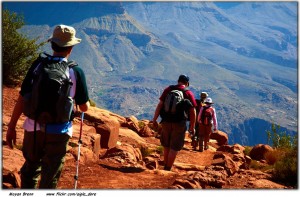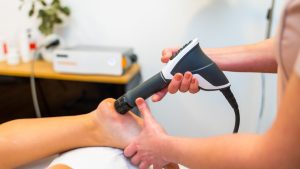 There is nothing more annoying than being in the great outdoors for some healthy exercise only to experience the negatives of sore, achy joints. This can often be the case with hiking. One of the most common ailments hikers complain of is knee pain, especially when going downhill. There are a few reasons why our bodies can suffer during this arduous task but a little know-how or specialist advice from a physiotherapist can put you back on track.
There is nothing more annoying than being in the great outdoors for some healthy exercise only to experience the negatives of sore, achy joints. This can often be the case with hiking. One of the most common ailments hikers complain of is knee pain, especially when going downhill. There are a few reasons why our bodies can suffer during this arduous task but a little know-how or specialist advice from a physiotherapist can put you back on track.
Generally people expect that going downhill should be easier on the joints of the body. Not true.
The knee is like no other joint in the body. Far from being a two dimensional ‘hinge’ joint the knee actually rolls and glides as it straightens and bends, with ligaments and muscles working hard to keep it fastened in place. As you descend from a hill the effect of gravity accelerates your body forward, with all that pressure transmitted through the knee via the femur (thigh bone). In order for you to descend at a constant, controlled speed (unless you want to roll down the slope that is…) you need to provide force against gravity to slow down. This is done by the muscles in your legs, most noticeably the quadriceps (thigh muscle). Hence that lovely deep burn you may experience!
So with gravity pulling you down and the quadriceps resisting such that you can walk it slowly and carefully it is akin to driving a car with the handbrake on… ouch! This adds up to compressive forces through the knee that are 3-4 times greater than that experienced during level walking.*
This ‘breaking’ effect does not occur whilst walking on level ground, nor going uphill. Hence more chance of knee pain on the way down. (And you thought that should be the easy part!) Help yourself: Preparing the supportive muscles of the knee joint can make for a better journey. I recommend a reverse step up. Start in front of a step, facing away from it. Slowly step backwards and up onto the step. Complete the movement in a controlled and slow manner, making sure the leg on the step is generating the force and you are not pushing off with the leg on the ground. Reverse the movement by slowly lowering the leg back to the ground and repeat. Other quick tips to minimise stress on the knees on your way down:
- Keep pack weight to a minimum.
- Don’t lock your knee straight when planting your foot on the ground.
- Zigzag or perform switchbacks where possible.
- Wear well fitted, high quality hiking shoes.
- Try a hiking pole.
- Pace yourself and build the difficulty of your hikes slowly.
- Warm up and stretch before heading out.
If you do experience knee pain when hiking a Central Health Physiotherapist can help diagnose the issue at hand and get you back on the path to success!
James O’Grady, Physiotherapist, Central Health Physiotherapy, Springdene Clinic, Barnet.
*Kuster M et al. Z Unfallchir Versicherungsmed 1993; 86 (3): 178-83 Stress on the femoropatellar joint in downhill walking- a biomechanical study.




